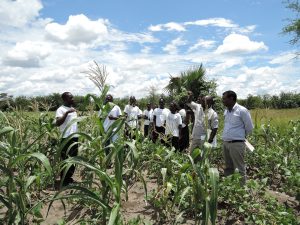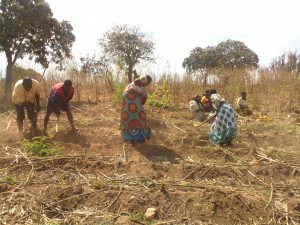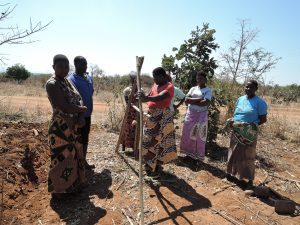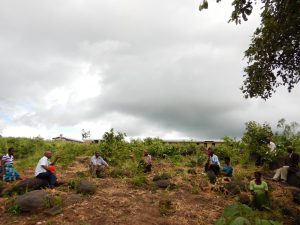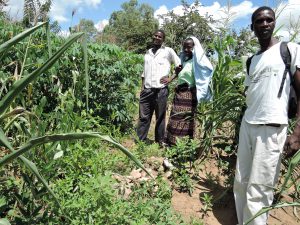#Participatory Approach #Equal Opportunity #Soil Erosion
✔ To harmonise soil conservation and livelihood upliftment of local communities through improved farming methods, the Government of Malawi and JICA adopted an Equal-Opportunity-for-All or PRRIE approach, preceding “Leaving No One Behind” pledged in 2030 Agenda for Sustainable Development/SDGs.
✔ PRRIE approach, characterised by its high cost-effectiveness, is a dissemination method systematised through Japanese cooperation in Senegal and subsequently customised for Malawi and Madagascar.
✔ The Equal-Opportunity-for-All approach was institutionalised in the Malawian Government’s work procedure by including it in the activity plans and budget request for the target districts.
Background

Large Gully in Middle Shire Area Source: COVAMS Newsletter(https://www.jica.go.jp/project/english/malawi/001/materials/pdf/newsletter_01.pdf)
Do you know what’s happening to the Shire River in Malawi, a landlocked country in southeast Africa?
Shire River is considered one of the most important water bodies in Malawi, as it generates 98% of the country’s hydroelectric power. It is also the water supply source of Blantyre, the second largest city in Malawi. However, the operation of these facilities is being disturbed occasionally by tremendous siltation in the Shire River. The silt comes from Middle Shire’s catchment area directly or indirectly through its tributaries.
What causes siltation?
The devastation of the environment brought about by tree cutting for supply of firewood and charcoal is the culprit of soil erosion evident everywhere in the catchment of Shire River. In addition, population growth in the area also accelerates the occurrence of soil erosion due to the establishment of new gardens with poor farming practices.
What can be done to mitigate siltation in Shire River?
One of the solutions is for the farmers to practice sustainable wood resource utilisation with consideration of soil conservation and improvement of farming methods that prevent soil erosion. However, it is not always easy to persuade farmers to do such sustainable practices because they are struggling in their livelihood, being stuck in such situation due to lack of money, shortage of food, and prevalence of diseases. The key to break away from the current state of things is to develop and demonstrate an effective and efficient approach to get their attention to soil conservation.
Project Details
What is COVAMS?
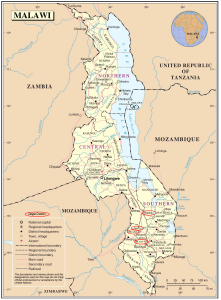
Project Site Map Source: United Nations(http://www.un.org/Depts/Cartographic/map/profile/malawi.pdf)
With the aim to secure the country’s power and water supply for the nearest city by conserving the environment in the Middle Shire, the Government of Malawi and the Japan International Cooperation Agency (JICA) initiated the Project for Community Vitalization and Afforestation in Middle Shire, or COVAMS Phase I (2007–2012) (COVAMS I), planned based on various survey results conducted since 1999.
COVAMS I introduced to farmers a wide range of techniques for soil conservation and tree planting with the Specified Village Training Approach, or COVAMS approach. The techniques were spread to over 30,000 households in 244 villages within two Traditional Authorities in Blantyre District in Middle Shire. In 2012, COVAMS I was upgraded to COVAMS Phase II (2007–2012) (COVAMS II), where the COVAMS approach was extended to 345 villages across Balaka, Blantyre, Mwanza, and Neno. COVAMS II took a step further to institutionalise the approach by assisting district departments to prepare annual plan and budget request for catchment management using the COVAMS approach, and by compiling guidelines and manual for this. COVAMS approach adopts a community-based rural development approach named PRRIE, or Participatory Rural Development and Resource Management by Integrated Training for Equal Opportunity.
What activities were carried out by COVAMS?
1. Community-Based Rural Development Approach: PRRIE
A community-based rural development approach named PRRIE, or Participatory Rural Development and Resource Management by Integrated Training for Equal Opportunity, was developed in PRODEFI project in Senegal by Mr. Naoto Noda from Hitonomori Co., Ltd. PRRIE was applied to two JICA projects: COVAMS in Malawi and PRODAIRE in Madagascar. The concept of PRRIE is to build the population’s basic capacity by holding a series of trainings as the first step; and seeks for further assistance, as the second step, if people demonstrate positive reactions after participating in trainings. This Equal-Opportunity-for-All approach preceded “Leaving No One Behind” pledged in 2030 Agenda for Sustainable Development/SDGs.
2. Features of COVAMS Training
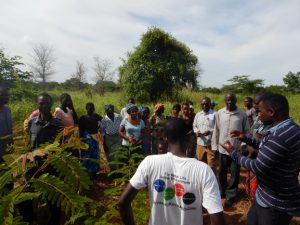
Trainings, such as the one pictured below, should (i) meet local needs, (ii) use locally available resources, (iii) be organised in village where people relevant to the project live, (iv) no selection of participants, and (v) target the majority of people.
To maximise villager’s opportunity for participation in training, all COVAMS training courses were held in villages. COVAMS trainings were opened to everyone, even mothers with their babies and elders. Then, the training could be repeated as long as there was demand on the ground. Technical follow up was easy as local lecturers, extension officers, or resource persons were utilised. Overall, the COVAMS’s trainings were organised based on the following five simple principles of PRRIE to assure equal opportunity for all while realising high-cost effectiveness.
On top of that, COVAMS provided various knowledge and skills including soil conservation, as well as galley controlling, soil conservation agriculture, and tree growing for villagers through the conduct of training courses; but no inputs were given. COVAMS only provided the villagers with necessary materials for practice purpose of training. There was no allowance or lunch provision, nor soft drinks given.
- Maize farming adopting the contour ridge method
- Training on contour farming by lead farmers
- Training on contour farming by lead farmers
- Training of trainers (senior lead farmers)
- Monitoring in tree planting area
- Monitoring on small-scale gully erosion control
3. Institutionalisation of Catchment Management Through Farmers’ Activities
The purpose of COVAMS II was to institutionalise Catchment Management Through Farmers’ Activities (CMFA) using COVAMS approach in target districts. How institutionalisation had been realised at all? COVAMS II set three (3) basic policies for institutionalisation:
i. Continuous improvement of the COVAMS approach: self-sufficiency, exit plan through localisation and simplification
ii. Linkage to budgeting process of the Malawian Government
iii. Following Malawian Government’s work procedures and rules
Based on the above policies, COVAMS managed to implement the institutionalisation of the CMFA by preparing activity plans for Fiscal Year 2018/19 and the budget request for CMFA using COVAMS approach of the target districts, and by letting COVAMS Guidelines be acknowledged by the Ministry of Natural Resources Energy and Mining (MoNREM); Ministry of Agriculture, Irrigation and Water Development (MoAIWD); and the Ministry of Civic Education, Culture and Community Development (MoCECCD).
[EN] Project Information
Written by Takuya Shiraishi
AI-CD Secretariat Support Team

